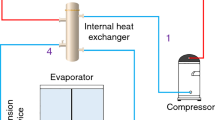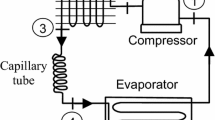Abstract
Various studies and arrangements have been made in recent years to reduce the effect of refrigerants used in cooling and heating systems on climate change. Environmentally friendly refrigerants with low global warming potential are required to reduce the negative impact of air-conditioning systems on climate change. HFO and HFC/HFO refrigerant mixtures (such as R513A) are thought to replace HFC refrigerants and are also commercially produced recently. In this study, R134a, R1234yf and R513A refrigerants have been investigated theoretically and experimentally under the same operating conditions. Refrigerants were tested at the same evaporator (− 10 °C, − 5 °C and 0 °C) and condenser (35 °C) temperatures. In addition, life cycle climate performance assessment analyses of refrigerants were performed. It is found that when the evaporator temperature is − 10 °C and − 5 °C, R513A has a higher COPHP than R134a. However, R513A has a lower COPHP than R134a at 0 °C the evaporator temperature. R1234yf has a high COPHP compared to R134a at the − 10 °C evaporator temperature while it has a low COPHP at − 5 °C and 0 °C evaporator temperatures. R513A and R1234yf refrigerants have 14.45% and 17.16% less emissions than R134a, respectively.










Similar content being viewed by others
Abbreviations
- \( \dot{W}_{\text{comp}} \) :
-
Compressor power consumption (kW)
- \( \dot{m}_{\text{ref}} \) :
-
Refrigerant mass flow rate (kg s−1)
- \( \dot{Q}_{\text{c}} \) :
-
Heating capacity (kW)
- h :
-
Enthalpy (kJ kg−1)
- COPHP :
-
Eat pump coefficient of performance (–)
- VCC:
-
Volumetric cooling capacity (kJ m−3)
- VHC:
-
Volumetric heating capacity (kJ m−3)
- \( \rho \) :
-
Density (kg m−3)
- C :
-
Refrigerant charge (kg)
- L :
-
Life time of heat pump (year)
- ALR:
-
Annual leakage rate (% of refrigerant charge)
- EOL:
-
End-of-life refrigerant leakage (% of refrigerant charge)
- GWP:
-
Global warming potential (kgCO2 kg−1)
- GWPadp :
-
GWP of atmospheric degradation product of the refrigerant (kgCO2 kg−1)
- AEC:
-
Annual energy consumption (kWh year−1)
- EM:
-
Electric power plant emission factor (kgCO2 kWh−1)
- m :
-
Mass of material (kg)
- MM:
-
CO2 produced/kg of material (kgCO2 kg−1)
- m r :
-
Mass of recycled material (kg)
- RM:
-
CO2 produced/kg of recycled material (kgCO2 kg−1)
- RFM:
-
Refrigerant manufacturing emissions (kgCO2 kg−1)
- RFD:
-
Refrigerant disposal emissions (kgCO2 kg−1)
- HFC:
-
Hydrofluorocarbon
- HFO:
-
Hydrofluoroolefin
- ODP:
-
Ozone depletion potential
- GWP:
-
Global warming potential
- LCCP:
-
Life cycle climate performance
- TEWI:
-
Total equivalent warming impact
- yr:
-
Year
References
Aprea C, Greco A, Maiorino A (2017) An experimental investigation of the energetic performances of HFO1234yf and its binary mixtures with HFC134a in a household refrigerator. Int J Refrig 76:109–117. https://doi.org/10.1016/j.ijrefrig.2017.02.005
Aprea C, Greco A, Maiorino A (2018) HFOs and their binary mixtures with HFC134a working as drop-in refrigerant in a household refrigerator: energy analysis and environmental impact assessment. Appl Therm Eng 141:226–233. https://doi.org/10.1016/j.applthermaleng.2018.02.072
Atilgan B, Azapagic A (2016) Assessing the environmental sustainability of electricity generation in Turkey on a life cycle basis. Energies 9:31. https://doi.org/10.3390/en9010031
Bobbo S, Fedele L, Curcio M et al (2019) Energetic and exergetic analysis of low global warming potential refrigerants as substitutes for R410A in ground source heat pumps. Energies 12:3538. https://doi.org/10.3390/en12183538
Choi S, Oh J, Hwang Y, Lee H (2017) Life cycle climate performance evaluation (LCCP) on cooling and heating systems in South Korea. Appl Therm Eng 120:88–98. https://doi.org/10.1016/j.applthermaleng.2017.03.105
Didion DA, Bivens DB (1990) Role of refrigerant mixtures as alternatives to CFCs. Int J Refrig 13:163–175. https://doi.org/10.1016/0140-7007(90)90071-4
Feng B, Yang Z, Zhai R (2018) Experimental study on the influence of the flame retardants on the flammability of R1234yf. Energy 143:212–218. https://doi.org/10.1016/j.energy.2017.10.078
Höbberg M, Berntsson T (1994) Non-azeotropic mixtures as working fluids in two-stage economizer-type heat pumps. Int J Refrig 17:417–429. https://doi.org/10.1016/0140-7007(94)90077-9
International Institute of Refrigeration (IIR). 2016 Guideline for life cycle climate performance
Lee Y, Kang DG, Jung D (2013) Performance of virtually non-flammable azeotropic HFO1234yf/HFC134a mixture for HFC134a applications. Int J Refrig 36:1203–1207. https://doi.org/10.1016/j.ijrefrig.2013.02.015
Li G, Eisele M, Lee H et al (2014) Experimental investigation of energy and exergy performance of secondary loop automotive air-conditioning systems using low-GWP (global warming potential) refrigerants. Energy 68:819–831. https://doi.org/10.1016/j.energy.2014.01.018
Llopis R, Sánchez D, Cabello R et al (2017) Experimental analysis of R-450A and R-513A as replacements of R-134a and R-507A in a medium temperature commercial refrigeration system. Int J Refrig 84:52–66. https://doi.org/10.1016/j.ijrefrig.2017.08.022
Meng Z, Zhang H, Lei M et al (2018) Performance of low GWP R1234yf/R134a mixture as a replacement for R134a in automotive air conditioning systems. Int J Heat Mass Transf 116:362–370. https://doi.org/10.1016/j.ijheatmasstransfer.2017.09.049
Mota-Babiloni A (2016) Analysis of low global warming potential fluoride working fluids in vapour compression systems. In: Experimental evaluation of commercial refrigeration alternatives. Universitat Politècnica de València, Valencia, Spain
Mota-Babiloni A, Navarro-Esbrí J, Barragán Á et al (2014) Drop-in energy performance evaluation of R1234yf and R1234ze(E) in a vapor compression system as R134a replacements. Appl Therm Eng 71:259–265. https://doi.org/10.1016/j.applthermaleng.2014.06.056
Mota-Babiloni A, Makhnatch P, Khodabandeh R, Navarro-Esbrí J (2017a) Experimental assessment of R134a and its lower GWP alternative R513A. Int J Refrig 74:680–686. https://doi.org/10.1016/j.ijrefrig.2016.11.021
Mota-Babiloni A, Navarro-Esbrí J, Mendoza-Miranda JM, Peris B (2017b) Experimental evaluation of system modifications to increase R1234ze(E) cooling capacity. Appl Therm Eng 111:786–792. https://doi.org/10.1016/j.applthermaleng.2016.09.175
Mota-Babiloni A, Belman-Flores JM, Makhnatch P et al (2018) Experimental exergy analysis of R513A to replace R134a in a small capacity refrigeration system. Energy 162:99–110. https://doi.org/10.1016/j.energy.2018.08.028
Ozcan H (2011) Performance determination of alternative refrigerants by using exergy method. Karabük University, Karabuk, Turkey
Taylor BN, Kuyatt CE (1994) Guidelines for evaluating and expressing the uncertainty of NIST measurement results—1994 edition
Yang Z, Wu X (2013) Retrofits and options for the alternatives to HCFC-22. Energy 59:1–21
Yang M, Zhang H, Meng Z, Qin Y (2019) Experimental study on R1234yf/R134a mixture (R513A) as R134a replacement in a domestic refrigerator. Appl Therm Eng 146:540–547. https://doi.org/10.1016/j.applthermaleng.2018.09.122
Zhang L, Zhao J, Yue L et al (2019) Cycle performance evaluation of various R134a/hydrocarbon blend refrigerants applied in vapor-compression heat pumps. Adv Mech Eng 11:168781401881956. https://doi.org/10.1177/1687814018819561
Zilio C, Brown JS, Schiochet G, Cavallini A (2011) The refrigerant R1234yf in air conditioning systems. Energy 36:6110–6120. https://doi.org/10.1016/j.energy.2011.08.002
Acknowledgments
The authors wish to thank all who assisted in conducting this research.
Author information
Authors and Affiliations
Corresponding author
Ethics declarations
Conflict of interest
The authors declare that they no conflict of interest.
Additional information
Editorial responsibility: S. Mirkia.
Rights and permissions
About this article
Cite this article
Yıldız, A., Yıldırım, R. Investigation of using R134a, R1234yf and R513A as refrigerant in a heat pump. Int. J. Environ. Sci. Technol. 18, 1201–1210 (2021). https://doi.org/10.1007/s13762-020-02857-z
Received:
Revised:
Accepted:
Published:
Issue Date:
DOI: https://doi.org/10.1007/s13762-020-02857-z




